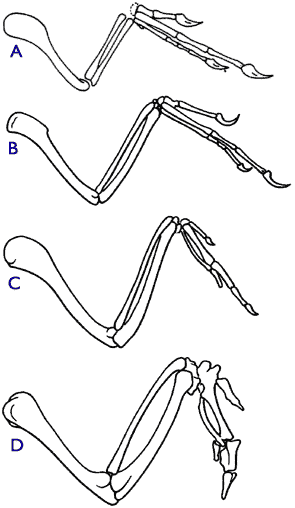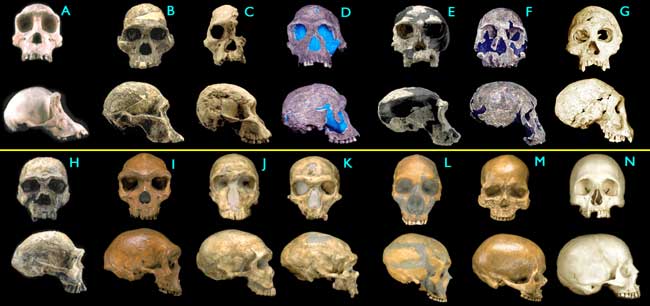Having covered in posts 1 and 2 why radiometric dating is considered reliable, how the geologic column appears, and how the cross correlation of radiometric dates, fossil composition, and layer depth in the column all converge on expectations it’s time to take a closer look at some of the transitional sequences in the fossil record. The Transitional Vertbrate Fossils FAQ at talk.origins does it very well so I’ll leave the listing to them:
Instead, here I’ll focus on just a few example transitions with some detailed discussion.
Reptiles to Mammals
The list provided at the link above for this particular transition is extensive, covering a sequence of 30 fossil species… the early quite reptilian, then reptilian but with some somewhat mammalian features… then reptilian with some more than somewhat mammalian features… then a solid mix of reptilian and mammalian features… then decidedly mammalian with reptilian features… then mammalian with some somewhat reptilian features, and finally mammalian with few if any reptilian features.
One particularly well illustrated example they proivide of what was occurring during this process is the development of the mammalian ear from reptile jaw structures… illustration here:
Starting at the far left side of the image we have the timescale of which periods each of the fossils are found from. As we move forward from the Carboniferous to the Jurassic we see the clear gradual change in the shape of the skeletal structure in each consecutive example. The left hand column of images if the view of the jaw from the inside. The right hand column is the view of the same jaw from the outside. The bone highlighted in yellow is the articular reptilian jaw bone, which eventually becomes the mammalian malleus (the “hammer” in the ear). The bone hignlighted in pink is the reptilian angular jaw bone, which eventually becomes the tympanic annulus in mammals. The bone highlighted in light blue is the reptilian quadrate jaw bone, which eventually becomes the mammalian incus (the “anvil” in the ear).
This particular sequence is also an excellent illustration of the gaping flaw in claims of “Irreducible Complexity”. Such arguments simply don’t understand how evolution progresses. Someone who held to the IC line of argument would look at something like the ear and say “Well, what good is an ear without the hammer? Huh? What good is half an ear? All those interconnecting bones would have to evolve all at the same time! That’s just silly... so the ear is Irreducibly Complex”. (And yes, people really do make that argument)
On the surface of it, if you don’t really understand how evolution operates, that article has a certain compelling appeal to common sense. People who haven’t been exposed to the full weight of the evidence for evolution and how it operates think that is a perfectly reasonable statement. It is however dead wrong, as we can clearly see. They look at a modern human ear, which is the product of millions of years of refinement to optimize it for operating with the structures available to it… and then just because after all that fine tuning if you suddenly come along and yank a gear out of the mechanism it stops working it couldn’t have developed gradually? Nonsense. Nobody with any knowledge of evolution would ever say that at some point in the past there was some animal with an ear that was completely missing a malleus… but otherwise was an ear exactly like a modern human with all the same bones in the same shape for no apparent reason whatsoever… just waiting around for a fluke mutation to pop that bone right in there out of nowhere. That is an absurd representation of evolutionary progression and does not remotely resemble what is encompassed by evolutionary theory. It is nothing but a flimsy strawman.
On to the next example:
Reptiles to Birds
Another of the big ones, and also another of the favorites of the Irreducible complexity crowd. “What good is half a wing?” is a question you’ll see asked quite often in Evo/Creo discussions.
Well, let’s just see about that by taking a look at another illustration courtesy of talk.origins:
Here we have four images of different forelimbs.
At the top we have Ornitholestes. A bipedal dinosaur found in the late Jurassic.
Below that we have the rather well known Archeopteryx, found at the very end of the Jurassic. Notice the forelimb skeletal structure is practically identical… the claws are a little more hooked, the second and third digits seem to have fused, the bones are just a slightly different shape… but Archaeopteryx is feathered. Apart from that it is clearly more reptilian than bird and there’s almost no chance it was capable of flight. At best it’s modified forelimbs provided it with some extra lift while leaping.
Below that we have Sinoris. An archaic bird from the Cretaceous. It had everything it needed anatomically to be fully flight capable. That’s right… that forelimb is an early version of a wing…. which still has the claws from when it used to be a forelimb on the end of it. I don’t exactly see a useless “half a wing” stage between those first three forms. Do you?
Below that is a modern chicken wing… which serves to demonstrate just how much a wing can change given 60 million years of evolutionary adaptation... but that’s a change between wing and wing so there’s hardly a need for a “half a wing” stage between those two. Unless of course, considering the rather unimpressive flight capabilities of the chicken, you consider them to have "half a wing".
Hominid Evolution
And for the final example… us. Back to talk.origins yet again for a pretty picture (because they have so many great ones):
Entries are:
A) Pan troglodytes, chimpanzee, modern
B) Australopithecus africanus, STS 5, 2.6 My
C) Australopithecus africanus, STS 71, 2.5 My
D) Homo habilis, KNM-ER 1813, 1.9 My
E) Homo habilis, OH24, 1.8 My
F) Homo rudolfensis, KNM-ER 1470, 1.8 My
G) Homo erectus, Dmanisi cranium D2700, 1.75 My
H) Homo ergaster (early H. erectus), KNM-ER 3733, 1.75 My
I) Homo heidelbergensis, "Rhodesia man," 300,000 - 125,000 y
J) Homo sapiens neanderthalensis, La Ferrassie 1, 70,000 y
K) Homo sapiens neanderthalensis, La Chappelle-aux-Saints, 60,000 y
L) Homo sapiens neanderthalensis, Le Moustier, 45,000 y
M) Homo sapiens sapiens, Cro-Magnon I, 30,000 y
N) Homo sapiens sapiens, modern
With the exception of the first skull, a modern chimpanzee for comparison purposes, all the skulls are arranged in chronological order. The blue pieces in the skulls are reconstructions, everything else is original fossil material. The progression should be obvious. Decreasing upper jaw protrusion, increasing brain cavity size, the changing brow ridges… on some other skulls (examples below) where dental records are more intact changing size of the canines is also evident.
I should also mention that the consensus view today I that the Neanderthal were not direct ancestors to modern humans but more like cousins. A very recent branch off of the hominid line which subsequently went extinct.
Now, if we were only to display B and N directly next to each other I doubt that there’s an anti-evolutionist on the planet who wouldn’t immediately declare something very like [I]“Well, one’s an ape and one’s a human. They’re obviously different. Don’t tell me you think we could have come from THAT”
But just put B and C next to each other and ask them if “microevolution” could change one into the other. I doubt they could deny it. And thus they would declare they were the same “kind” and this was only minor variation within kinds.
Only put C and D next to each other and ask.
Only put D and E next to each other and ask.
Etc…
This is clearly a transitional sequence between a modern human form and an early primate form… exactly the thing it creationists are constantly claiming doesn’t exist.
For a better of view of some of these fossils click this link then follow the instructions below it:
Human Evolution: The fossil evidence in 3D
-Click on “Enter the Gallery”. Don’t have pop-ups disabled.
-Along the bottom of the window that opens click on the seconf last image that looks like a gorilla (it’s actually a chimp).
-If you click and drag on the skull that comes up you can rotate it through a full 360 degrees. This lets you get a much better look at the overall shape of the skull. Also, if you hold down the shift key then click and drag you can measure the skull since they aren’t displayed to scale
-After that move on and click on the picture of the human, the bottom sequence will zoom in to show a progression of fossil hominids. You can click on each of them and manipulate them the same way. They are also arranged in chronological order as they are dated and found in the column.
To sum up... the claim that "there are no transitional fossils" has been around for a very long time... and it has been completely wrong for a very long time.



No comments:
Post a Comment